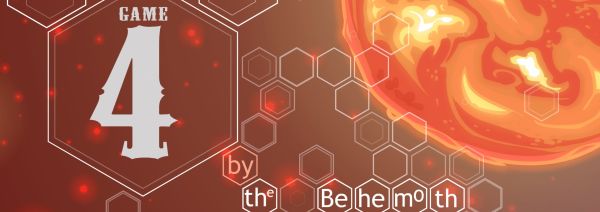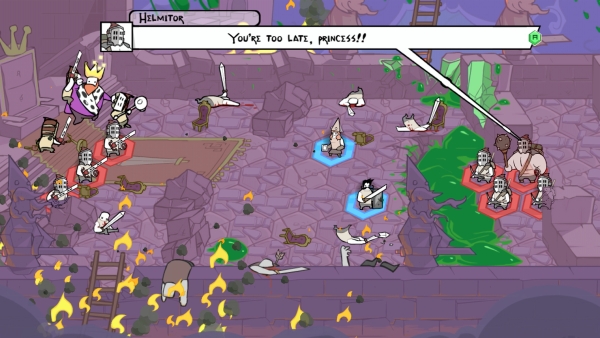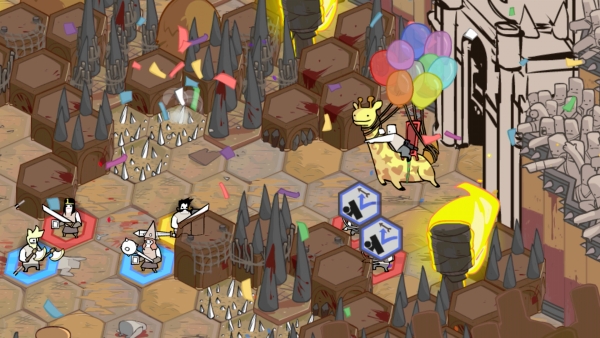
Once again, The Behemoth built an elaborate demo station for their currently untitled turn-based strategy game, Game 4, at this year’s PAX East expo. In previous years, the developer has outfitted its arcade-like offerings in arcade cabinets, but the more tactical gameplay of Game 4 required something a bit more elaborate. So out went the arcade cabinets and in came a towering command module complete with a Y-shaped lever that set the action into motion.
Platforms: PC, Xbox One
Publisher: The Behemoth
Developer: The Behemoth
Genre: Turn-Based Strategy X The Behemoth
Release Date: TBA
ESRB Rating: Rating Pending
If this is Game 4, then surely The Behemoth must have preceded it with three other games, right? And indeed they did. But nothing they did before could prepare players for Game 4. Alien Hominid was a shooter in the mold of Contra or Metal Slug. Castle Crashers took out the guns and replaced them with the melee brawling found in your typical beat ’em up… though the game was anything but typical. Finally, 2013’s BattleBlock Theater took away the guns and the swords for a pure platforming experience. While all three games can be slotted into different genres, they were built off the side-scrollers we grew up with in the 80s and 90s. So in that way, Game 4’s turn-based strategy is even more of a departure. And yet, it’s not.
For Game 4, The Behemoth has once again hired Will Stamper to narrate the action. BattleBlock Theater benefited greatly from Stamper’s narration, and his zippy rhythm kept Game 4 moving as well. He opens the demo by narrating an opening movie that depicts a giant space bear crashing into Earth. The bear causes chaos and destruction and toxic green bear blood is still raining down on the citizenry years later. If you’re a Behemoth fan, I’m sure you feel right at home already.
Always looming in the background, the bear gives way to Horatio, a “humble blueberry farmer” who is forced to defend his farm from roving bands of vandals. Using standard turn-based strategy tactics, Horatio positions himself between his house and the vandals and fights them off on a hex-based field. But a massive bear paw crushes his house and flattens his boy, forcing Horatio to venture to The City.
On his journey, Horatio will meet several other adventurers, including Princess Pipistrella and a surfer cyclops. As the narrator forces Horatio to share his blueberries, the game doles out some of the tactical information you’ll need to know, including defensive maneuvers (characters with shields can block arrows), weapons handling (clubs are better than swords against armored characters), and movement (the player can only place the characters; the characters decide who they’ll attack and how). All of this information is easy to follow thanks to The Behemoth’s trademark hand-drawn art style.
After these introductory moments, Horatio and his band of merry adventurers head to The City, a bustling metropolis that includes an arena (for building up gold reserves in a neverending series of fights) and your new house (for equipping new weapons). From The City, they can venture out even further into Game 4’s world, where they meet Sofia, a “Recruitador,” who can use her magical net to add enemy characters to your team.

Game 4 is incredibly fast-paced for a strategy game, but I never felt like I was being forced to slam down the execute lever without a strategic plan. The developers have often talked about creating a tactical strategy game for people who don’t like tactical strategy games, and I think they’ve done it. That said, if you’re already a fan of the tactical strategy genre, Game 4’s unique setting is just the icing on the cake of a great experience.
And speaking of cake, the sentient cupcakes that The Behemoth has been using to promote Game 4 actually play a big part in the action. Once you’re able to recruit characters, the strategy in Game 4 become much more about which characters you bring with you. Because you’re not responsible for spellcasting and individual attacks, if you want a character that specializes in healing or offensive magic or brawling, you’ll have to recruit a character that has those skills. The sentient cupcakes, for example, love to heal people. I have to admit, even outside the twisted logic that The Behemoth often employs, this characterization actually makes total sense. Doesn’t everybody feel better after eating a cupcake?
This commitment to characterization and world building is all over Game 4’s preview build. All the characters speak some kind of unintelligible gibberish, but Horatio, Pipistrella, the surfin’ cyclops, and Sofia all come across as real characters. Will Stamper’s crackerjack narration (I’m not entirely sure, but he might be playing God as an ornery prankster) only adds to this. Most important of all, the Game 4 demo only included about 30 minutes of the game, so it’s just a taste of what’s to come. Who knows how many character types will eventually show up, and how crazy they’ll be? Knowing The Behemoth’s history, I’m going to go with “a lot” and “very.”

The only downside to how fully The Behemoth has merged their style with a turn-based strategy game is that the hard-drawn artwork makes some of the menus a bit hard to follow. I’m sure the doodles, graphs, scribbled notes, and other information delivery systems will make sense eventually, but this lack of clarity could be a problem for a stat-heavy game like Game 4.
The Behemoth has yet to disappoint me, and Game 4 is shaping up to be yet another triumph. Sadly, it doesn’t currently have a release date, so it may be a while before we can fully dive into their twisted take on the turn-based strategy game on the Xbox One or Steam.







